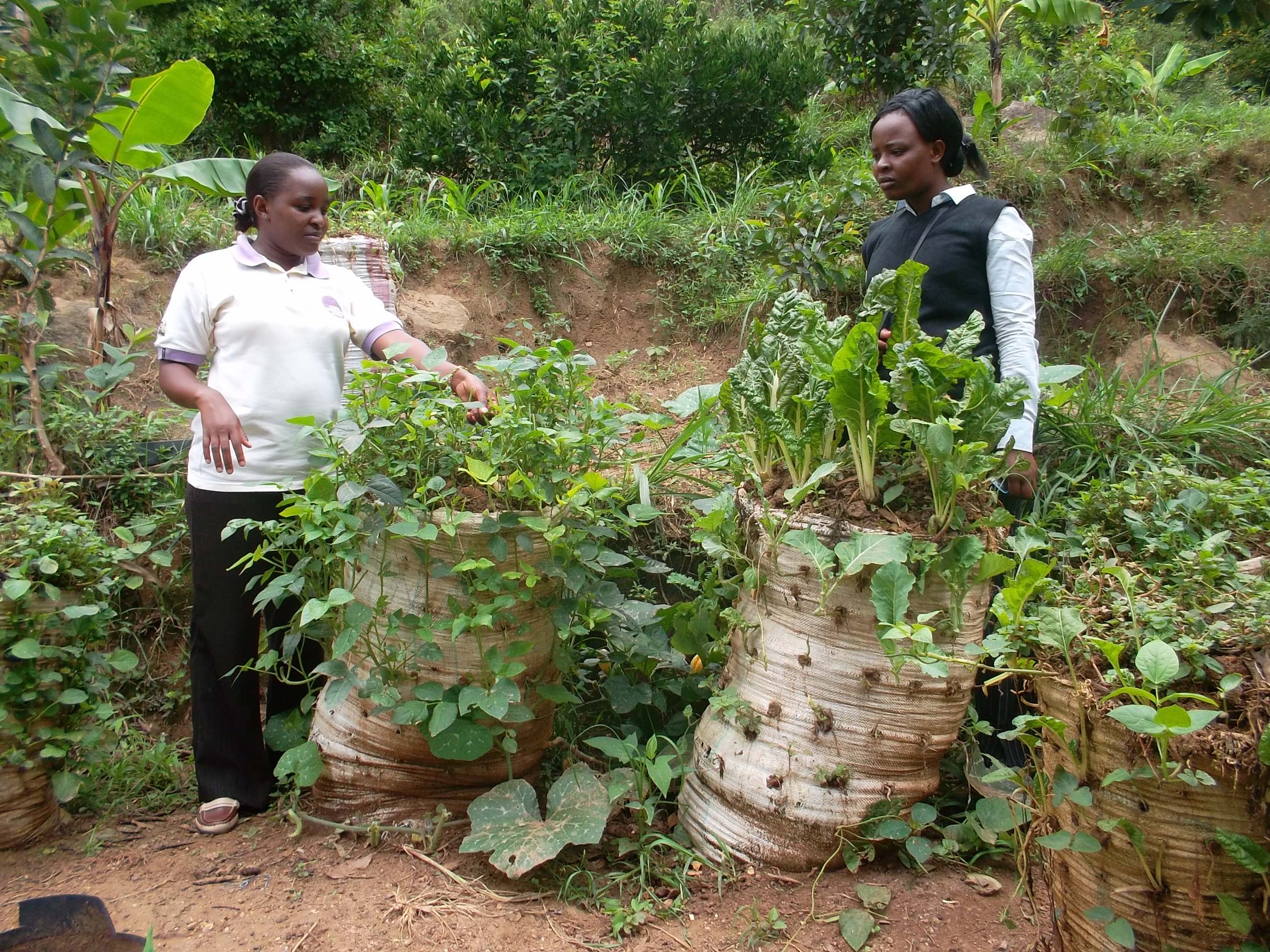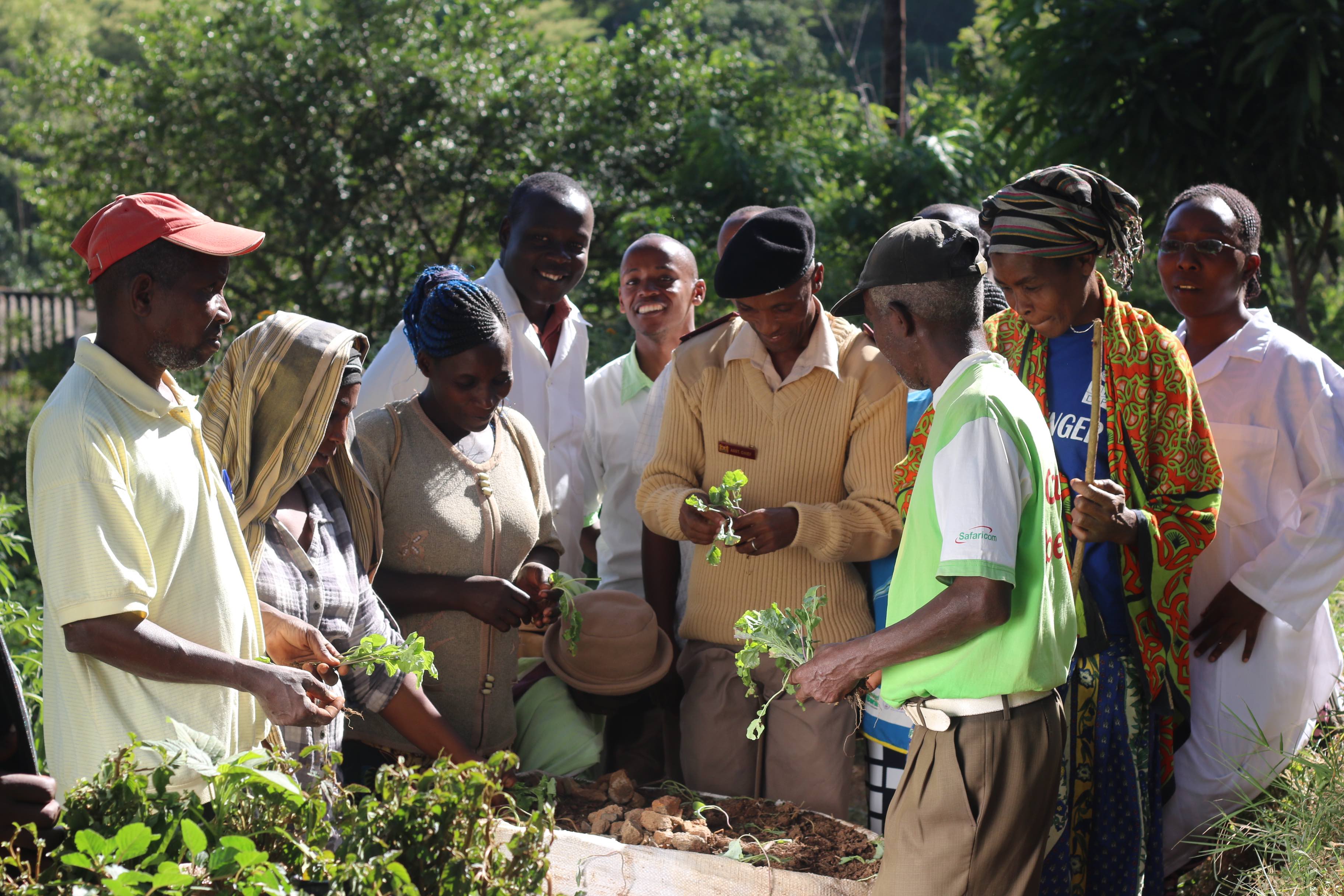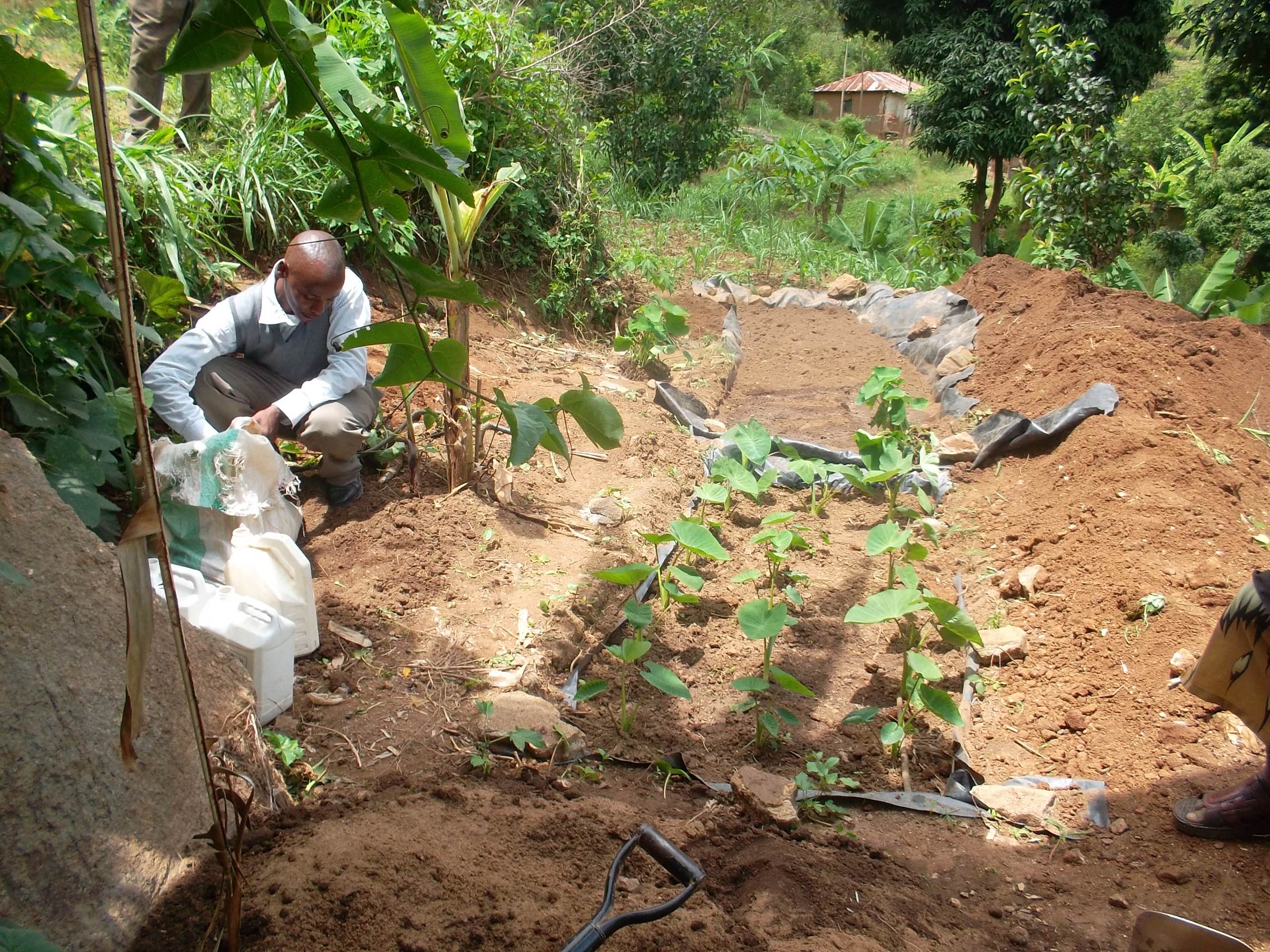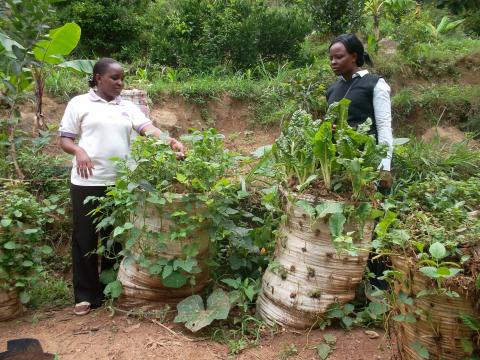Improving food and nutrition security for households with underweight children in Taita Taveta County, Kenya
By Dancliff Mbura, Caroline Chiedo, Fridah Mutea and Amelia Reese-Masterson
Amelia Reese-Masterson is Research Advisor at IMC, providing technical guidance and oversight for nutrition, food security, and livelihoods research projects globally. She holds an MPH from Yale School of Public Health, with a focus on nutritional epidemiology.
Dancliff Mbura is currently working with IMC as a programme manager for a European Union- funded project in Taita Taveta County. He has a degree in Foods, Nutrition and Dietetics from Egerton University of Kenya.
Caroline Chiedo is a certified nutritionist and is Deputy National Nutrition Manager for IMC in Kenya. She is currently a Master of Public Health Candidate and holds a bachelor’s degree in Foods, Nutrition and Dietetics.
Fridah Mutea is the National Nutrition Programme Manager with IMC in Kenya. Her current roles involve creating strategic direction and guiding the country nutrition programme as well as providing technical support to the nutrition field teams. She holds a bachelor’s degree in Foods and Nutrition.
The authors would like to acknowledge the European Union as funder, partners World Vision Kenya and St. Joseph’s Shelter of Hope and the Government of Kenya, including all involved ministries.
Location: Kenya
What we know: The role of multi-sectoral initiatives in addressing malnutrition is reflected in Kenyan National Food and Nutrition Security Policy and associated action plans.
What this article adds: A collaborative, three-year programme of Integrated Maternal Child Health, Nutrition and Family Planning in Taita Taveta County in Kenya targeted the households of 200 underweight children with agriculture or livestock interventions accompanied by messaging on nutrition, water, sanitation and hygiene (WASH) and health-seeking behaviours, and establishment of hand-washing stations at household level. Adequate Integrated Management of Acute Malnutrition (IMAM) services were not available in the programming area. Ministries of Health, Agriculture, Programmes, and Interior Coordination were actively involved. Community health workers and community groups were central to delivery of the interventions. The children recovered (achieved weight-for-age >-1 Z-score) and the minimum acceptable diet rose from 23.5% (2013) to 33.85% (2015) among children under two years old. ‘Bonus’ developments included stakeholder’s initiative to identify markets for surplus products, which generated income.
Background
 Kenya, like many other countries, has put more and more effort into curtailing the heavy burden of malnutrition. One of the ways Kenya has demonstrated this effort is in development of the Food and Nutrition Security Policy, which addresses nutrition security in the country. The policy places nutrition central to human development and emphasises the need to ensure the rights to good nutrition, recognises disparities in nutrition, and provides relevant policy directions while ensuring a multi-sectoral approach to addressing malnutrition in the country.
Kenya, like many other countries, has put more and more effort into curtailing the heavy burden of malnutrition. One of the ways Kenya has demonstrated this effort is in development of the Food and Nutrition Security Policy, which addresses nutrition security in the country. The policy places nutrition central to human development and emphasises the need to ensure the rights to good nutrition, recognises disparities in nutrition, and provides relevant policy directions while ensuring a multi-sectoral approach to addressing malnutrition in the country.
According to the Kenya Demographic and Health Survey (KDHS) 2014, it is estimated that 26% of children under five in Kenya are stunted and 4% are wasted. The Kenyan Government, in collaboration with nutrition partners, has put in place a National Nutrition Action Plan 2012-2017, which is a coordinated framework for nutrition interventions, outlining 11 strategic objectives and corresponding intervention actions.
International Medical Corps (IMC), in partnership with World Vision Kenya and a local organisation, St. Joseph’s Shelter of Hope, is implementing a three-year (February 2013-January 2016), European Union-funded project called Integrated Maternal Child Health, Nutrition and Family Planning (IMCHNFP) in Taita Taveta County in Kenya. Taita Taveta is one of the six counties in the coastal region of Kenya characterised by a rapidly growing population, dry climatic conditions, food insecurity and high poverty levels. The project’s overarching goal is poverty reduction in the context of sustainable development, including the pursuit of Millennium Development Goals 4 and 5, to reduce child mortality and to improve maternal health. Currently, the project is aimed at Sustainable Development Goal 2 (ending hunger and achieving food security and improved nutrition and promoting sustainable agriculture) and Goal 3 (ensuring healthy lives and promoting wellbeing for all at all ages).
The project has three specific objectives:
- Enhanced access to maternal child health services;
- Improved nutrition status for pregnant and lactating women (PLW) and children under five; and
- Scaled-up access and uptake of reproductive health services.
IMC is leading on the second objective. World Vision and St. Joseph’s are leading on objectives one and three; St Joseph’s focuses on all activities that are implemented at the community level, while World Vision supports implementation at health facilities. Through this project, IMC is addressing various strategic objectives outlined in the Kenya National Nutrition Action Plan. The implementing agencies work collaboratively to ensure maximum impact for improved health outcomes. This one-stop-shop approach to health service provision ensures that, for example, a mother taking a child for immunisation services is able to access nutrition services (counselling and micronutrient supplementation) and family planning services at the same time.
IMC is also implementing nutrition-sensitive programming, which complements direct nutrition interventions. According to a nutrition survey conducted in Taita Taveta in November 2013, minimum dietary diversity among children aged 6-23 months was found to be 23.5%, and stunting rates among children aged 6- 59 months was 27%. More recently, the KDHS from 2014 found stunting rates among children aged 6-59 months of 23.8%; slightly lower than that found the previous year in Taita Taveta. Although there are no recent data on minimum dietary diversity among children under five, the rate is likely similar to or slightly improved from the 2013 statistic. Poor dietary diversity has been linked to both stunting and wasting; in the target population, it was found that the most stunted children were also underweight, with poor dietary diversity cited as a likely risk factor. This need for improved dietary diversity in order to improve nutritional status formed the basis for the project’s holistic intervention approach: addressing health and nutrition behaviours and practices through both nutrition-sensitive and nutrition-specific interventions.
This article describes the nutrition-sensitive programming approaches IMC has applied, including kitchen gardening, livestock keeping and WASH activities, and highlights key successes, challenges and lessons learned.
Nutrition-sensitive programming
The project targeted pregnant and lactating women (PLW) (MUAC < 23cm) and underweight children under five (weight-for-age (WAZ) <-1 Z-score) identified through active case-finding in the community and at health facilities. Health workers did not have capacity to measure height, so WAZ was used rather than weight-for-length. The WAZ cut-off for children reflects the cut-off point in the mother-child booklet distributed by the government to all health facilities offering mother and child health and nutrition services. These booklets are then issued to the mothers and children attending clinic. At the health facility, underweight children are further assessed; children are weighed again, the measure is recorded in the child welfare clinic register (see below), and they undergo medical examination. Intervention involves nutrition counselling where caregivers are advised on what their children should eat, with attention to food variety. They also receive routine services provided to all the children, such as immunisation and vitamin A supplementation. For the child to be considered successfully recovered, he/she must achieve a score greater than WAZ -1.
At the time, there was no fully functional IMAM programme due to lack of adequate capacity in existing health services. Difficulties in some centres had emerged around reporting that impacted on supply chain and compromised service delivery. Taita Taveta County had not received any recent formal training on IMAM, and in the areas IMC was implementing the kitchen gardening and small-stock activities, there were no IMAM activities being implemented in the covering health facilities. However, on-the-job training on High Impact Nutrition Interventions (HINI), which includes IMAM, has been ongoing since the programme began; planning is currently underway (January 2016) to support training on IMAM and develop capacity, involving the Ministry of Health (MoH), WFP and IMC.
The malnourished women identified receive nutrition counselling from health workers. In the areas where IMC has successfully implemented the kitchen gardening and small-stock activities, the women are referred to the groups for mentorship from fellow women on improving household food security through kitchen gardening and rearing of small stock. In these groups, they also receive relevant farming information from area agricultural extension officers.
At the health facilities, the weight and age of all children under five that attend the facility are recorded in a permanent child welfare clinic register, including those identified through active case-finding. For the project in question, 200 underweight children were selected from the register and their caregivers provided with counselling on appropriate infant and young child feeding practices and supported with either kitchen gardening or small-livestock interventions. Representatives from the Ministry of Agriculture, MoH, and Ministry of Special Programmes, county/sub-county nutrition focal persons, community authorities and community health workers participated in the selection of these households. The 200 households (with one child per household) were selected based on the following key factors:
- poverty level of the household in addition to underweight status of the child;
- inability to access food at household level;
- proximity to active community units (to enable close follow-up by the community health volunteer);
- topography and climatic conditions of the village where the children came from (the areas with relatively humid climates were targeted for sack farming interventions while the arid areas were targeted with livestock interventions);
- willingness of the caretakers to engage in farming or small livestock rearing; and
- living in one of the five sites selected for the kitchen and small-stock farming.
Applying these criteria, 100 beneficiaries in Mbale and Njukini, of Wundanyi, and in Taveta sub-counties were identified for support, with farm inputs consisting of fertilisers and seeds for sack farming (kitchen gardening). Sack farming was encouraged as a means of farming since little water and space was needed. The agricultural extension workers provided training on kitchen gardening to equip the households with appropriate farming techniques. The training included the planting process, crop-care process, harvesting, post-harvest handling and preservation methods when the harvest is in surplus. Appropriate information on pest control and management at farm and storage level was also provided. The households supported with farm inputs were also encouraged and supported to set up communal nurseries. This was necessary to ensure the households worked in teams to support each other, as well as minimise the chance of failure. In addition, 100 households were selected in Sagala, Maktau and Ndilidau areas of Voi, Mwatate and Taveta sub-counties for support with animal stocks. They were provided with rabbits, goats and chickens. These households were also trained on animal husbandry and how to maximise yields from their animals. The topics included choosing appropriate animal breeds, breeding, feeding, disease, pest control and management, and animal housing.
Government representatives from the Ministry of Interior Coordination to the area chief participated to ensure the beneficiaries used the input provided for the intended activity. The area chiefs were also instrumental in promoting the interventions at the community level, as well as mobilising other community members who were not selected to take up such interventions.
 As a way of increasing the coverage of kitchen garden interventions, the stakeholders agreed to involve the community health volunteers; not only to monitor the interventions but also to practice kitchen gardening themselves. This would give them hands-on experience to enable them to train other community members, as well as scale up the interventions. A community unit is the lowest administrative level of the health system, rooted in the principles of universal health access and improved service delivery at the community level. It comprises a network of 50 frontline community health workers who deliver comprehensive primary healthcare services to households within the community unit and refer clients to the peripheral health facility for advance care. Each community volunteer provides these services to 20 to 30 households within the community unit. The nutrition officers in the MoH were involved in training the beneficiaries on food preparation methods for nutrient retention, selection of vegetables with high micronutrients levels, and the importance of micronutrients in the body, including their impact on the immune system. The training also included the importance of consumption of high protein foods from animal sources, especially among the children.
As a way of increasing the coverage of kitchen garden interventions, the stakeholders agreed to involve the community health volunteers; not only to monitor the interventions but also to practice kitchen gardening themselves. This would give them hands-on experience to enable them to train other community members, as well as scale up the interventions. A community unit is the lowest administrative level of the health system, rooted in the principles of universal health access and improved service delivery at the community level. It comprises a network of 50 frontline community health workers who deliver comprehensive primary healthcare services to households within the community unit and refer clients to the peripheral health facility for advance care. Each community volunteer provides these services to 20 to 30 households within the community unit. The nutrition officers in the MoH were involved in training the beneficiaries on food preparation methods for nutrient retention, selection of vegetables with high micronutrients levels, and the importance of micronutrients in the body, including their impact on the immune system. The training also included the importance of consumption of high protein foods from animal sources, especially among the children.
During the entire period, key messages on infant and young child nutrition were delivered, as well as other important messages such as good health-seeking behaviours, care of children, and good hygiene and sanitation practices. Beneficiaries were advised to practice a high standard of hygiene by ensuring handwashing with water and soap at four critical points: before eating, after visiting the toilets, after cleaning the baby (after defecation), and before meal preparation. They were also advised on keeping sanitation facilities clean and setting up handwashing points near the toilets in order to promote handwashing immediately after toilet use. The 200 households, with the guidance of the area public health officers, established hand-washing stations (also known as tippy taps), which they use for hand-washing at their homesteads.
Key successes related to the nutrition-sensitive interventions
Among the 200 households who received nutrition-sensitive interventions, IMC identified a number of key successes. All 200 underweight children in the households participating in kitchen gardening and stock rearing recovered (i.e. they achieved WAZ >-1), with no notable difference between the two groups in terms of recovery time. As noted earlier, these children were not, at the time of data collection, receiving nutrition-specific interventions such as IMAM. Additionally, recent assessment found improvement in the minimum acceptable diet in children under two years old in the 200 households from 23.5% (2013) to 33.85% (2015), which could be linked to the kitchen gardening and livestock interventions, among other initiatives. Regular field-monitoring visits revealed that children were being fed eggs, vegetables and milk produced through kitchen gardening and small-stock activities. Another key success was related to the Government’s buy-in to the project. The Government expressed remarkable support for kitchen gardening, and the number of people practicing kitchen gardening increased from 96 at baseline to over 500 at midpoint. This shows Government ownership of the project and potential for sustainability.
 Added benefits are that, over time, the farmers have been able to form groups where they discuss solutions to challenges related to the market and surplus production. One solution was to maintain group membership; another was to assess market value of their products and identify markets for surplus production. These groups have also ventured into table banking, whereby they save and then lend money to members (table banking is a group-funding strategy in which members meet regularly, place their savings, loan repayments and other contributions on the table, and then borrow long-term or short-term loans as needed). This project is attracting support from the Government and other local banks, who also train the farmers on marketing opportunities available. Participants have reaped economic benefits by selling extra farm and livestock yields, venturing into small-scale business, and forming investment groups through table banking. These economic benefits contributed to further improving their food security.
Added benefits are that, over time, the farmers have been able to form groups where they discuss solutions to challenges related to the market and surplus production. One solution was to maintain group membership; another was to assess market value of their products and identify markets for surplus production. These groups have also ventured into table banking, whereby they save and then lend money to members (table banking is a group-funding strategy in which members meet regularly, place their savings, loan repayments and other contributions on the table, and then borrow long-term or short-term loans as needed). This project is attracting support from the Government and other local banks, who also train the farmers on marketing opportunities available. Participants have reaped economic benefits by selling extra farm and livestock yields, venturing into small-scale business, and forming investment groups through table banking. These economic benefits contributed to further improving their food security.
Challenges
During the course of the project, the most serious challenge faced had to do with barriers to community buy-in. Some community members prefer immediately realisable support, e.g. food aid. This challenge was addressed by holding regular discussions with programme participants on how undernutrition (both acute and chronic) impacts a child, and how food aid can displace local production and is not a sustainable solution. A second challenge related to market routes for surplus yield to be sold in order to reduce wastage and losses. The agricultural extension workers trained the farmers on post-harvest storage and, together with beneficiaries, engaged in discussions on market avenues available.
Lessons learned
By integrating nutrition-sensitive interventions – home gardening, small-stock provision and hygiene education – into a broader set of interventions, we were able to implement a well-coordinated, multi-sectoral project with strong stakeholder partnerships at all levels. At the community level, the community health workers and agriculture extension workers partnered in engaging the communities to improve household food consumption and thus improve their children’s diet. At the county leadership level, the Ministries of Agriculture, Livestock and Health worked together to contribute to the agenda of improving nutrition at the household level.
There is a need to institutionalise multi-sectoral collaboration for nutrition-sensitive programming to ensure success. This project provided an example of such collaboration. Furthermore, strengthening of the existing county multi-sector steering group (which is coordinated by the National Drought Management Authority) should be explored, as this forum brings various sector heads and representatives together to discuss ongoing activities across sectors within the county, and occasionally includes nutrition on its meeting agenda. Such fora can be utilised to address the underlying causes of malnutrition and, in the long run, push forward the nutrition agenda.
For more information, contact: Caroline Abla, Director; Nutrition, Food Security & Livelihoods; International Medical Corps.

